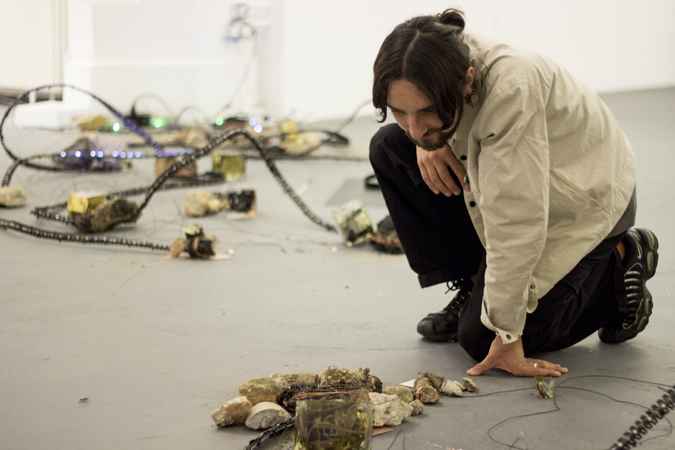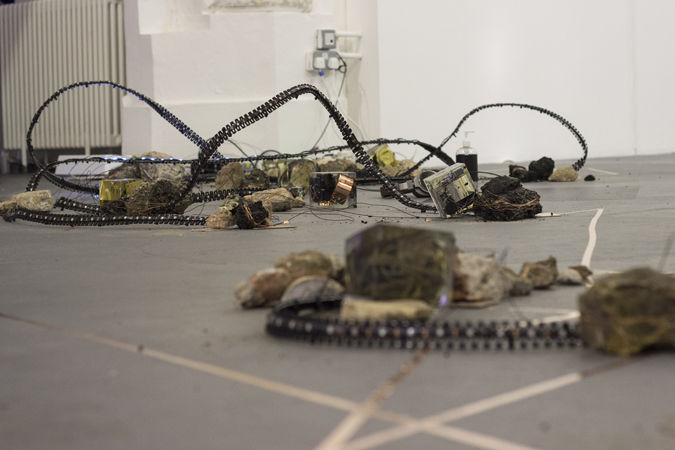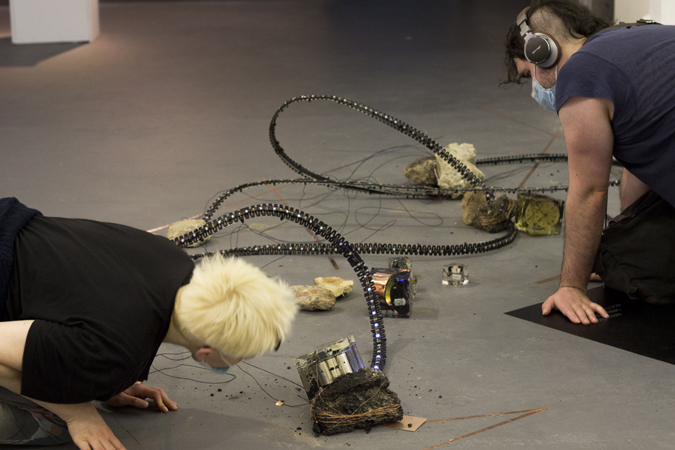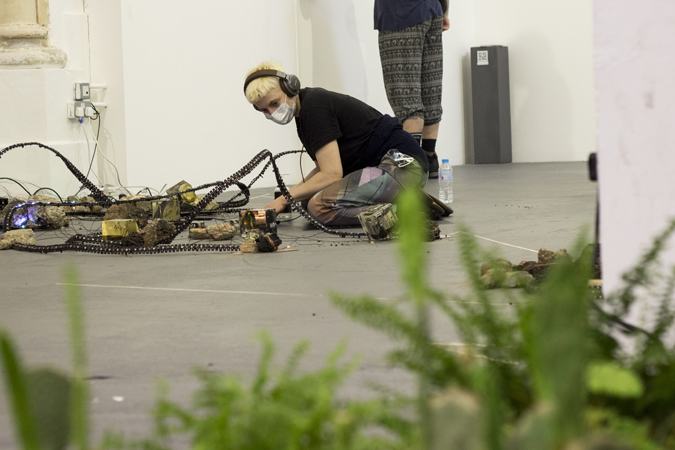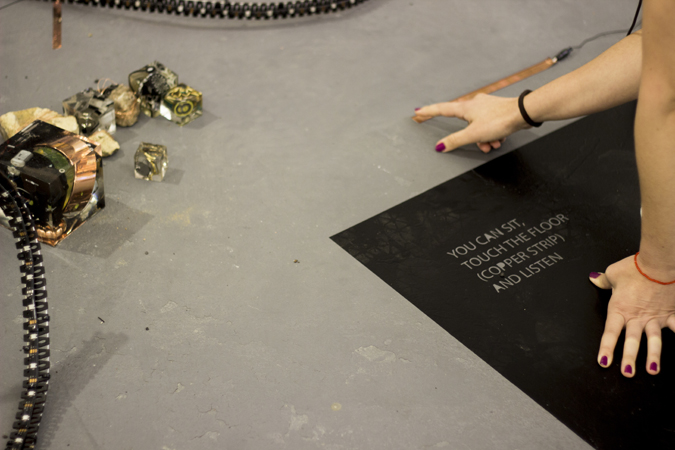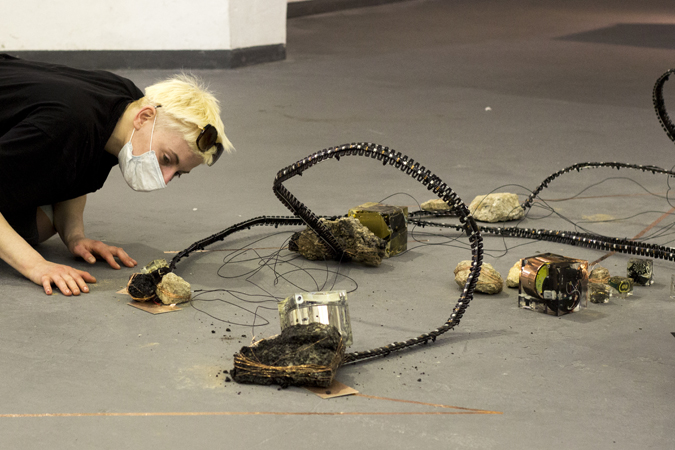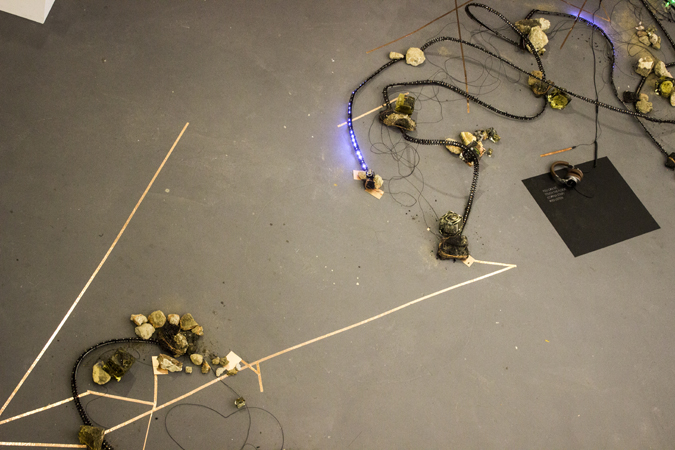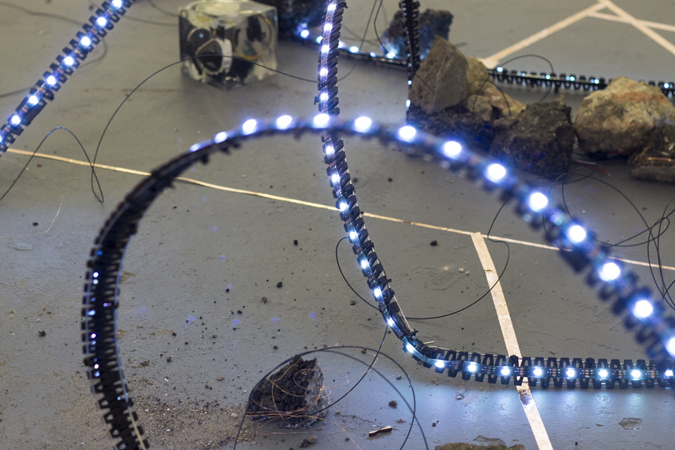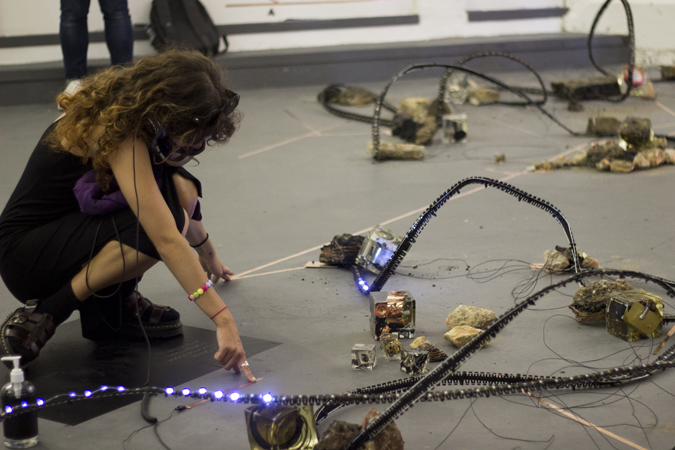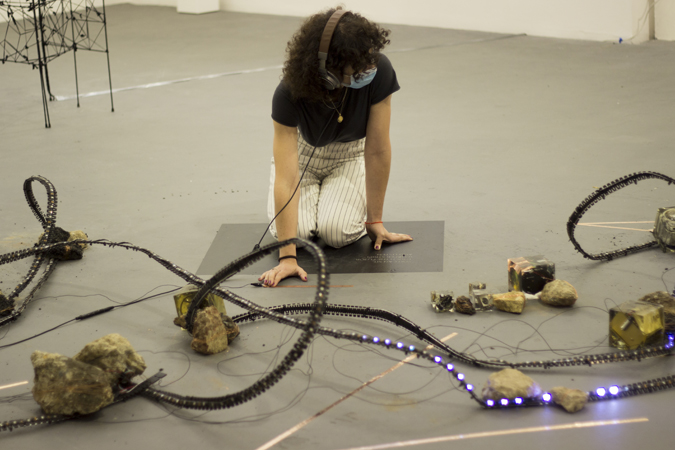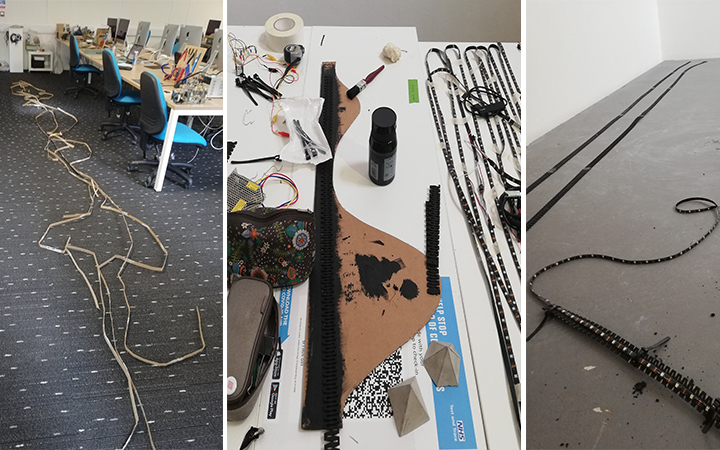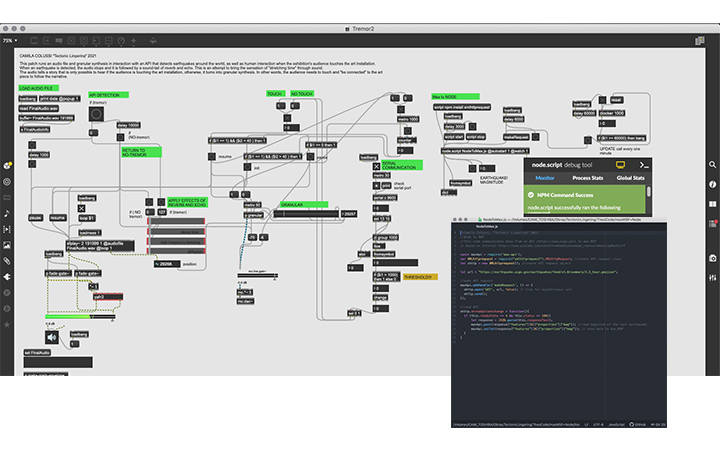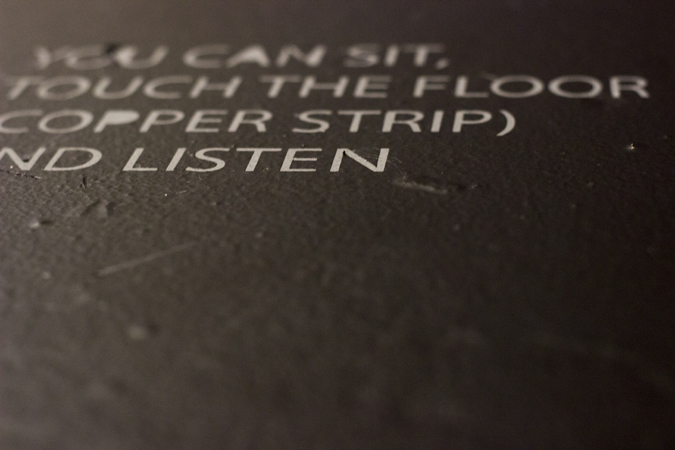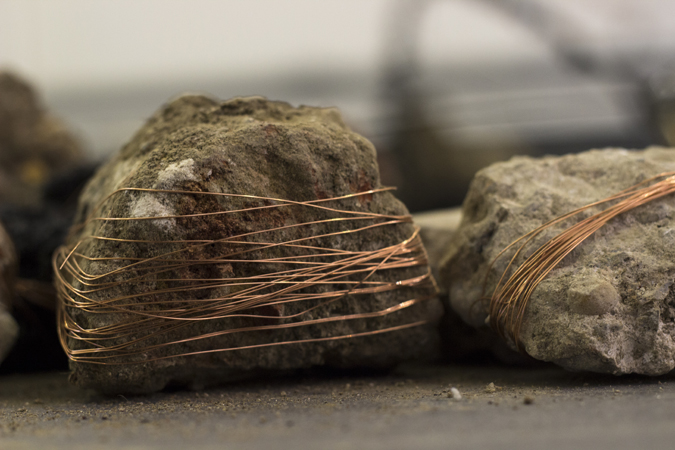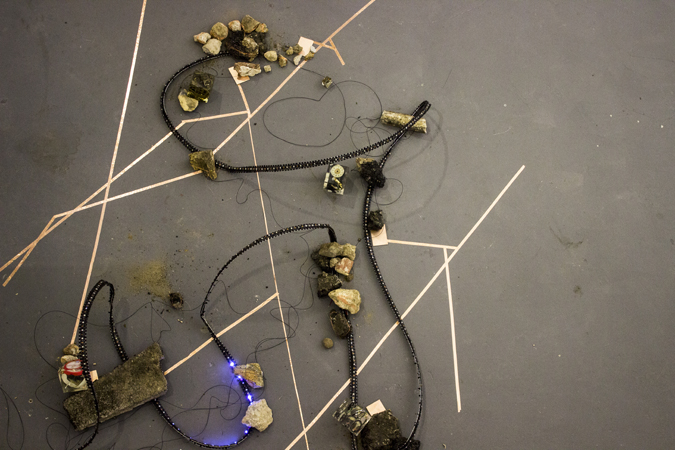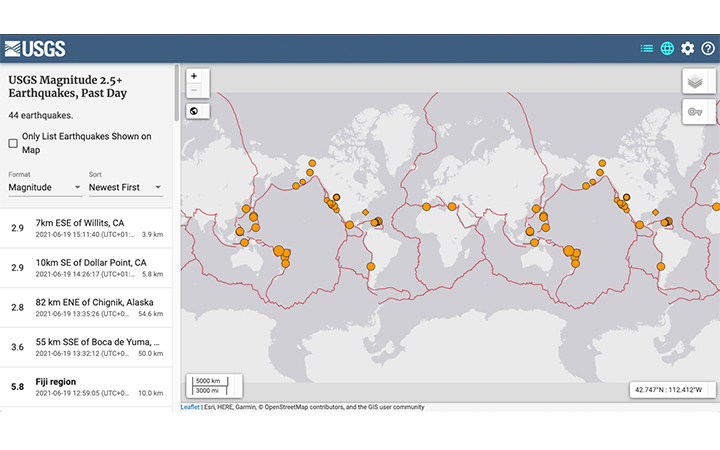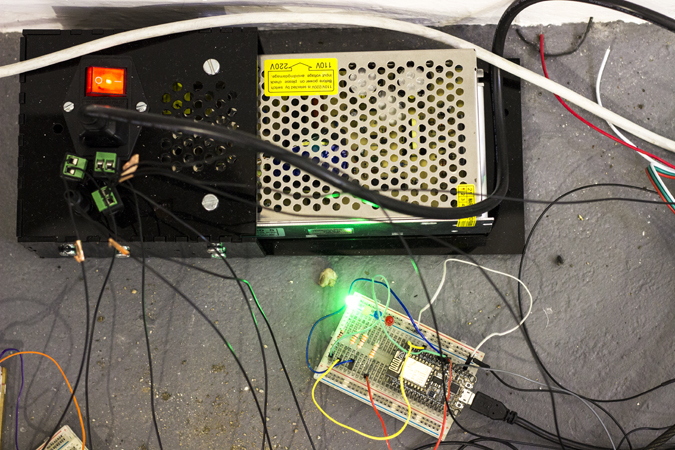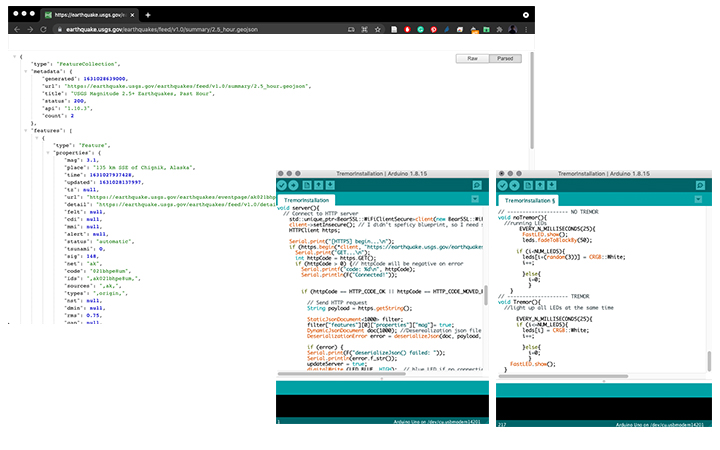Tectonic Lingering
Sound-light interactive installation. The piece is connected to real-time earthquake-data coming from different places around the world. Beams of light move in expectation of a new quake. If a tremor is detected, the whole piece lights up for a durational-time linked to the quake’s magnitude. If the audience touches the piece, it triggers sounds that tell stories about time and tremors.
#microPoliticsOfTime
#reConnectingEarth
#sensingPractices
artwork by: Camila Colussi
Introduction
Tectonic Lingering is a project that intersects an art research about time, lingering and duration; and my personal approach to earthquakes — based on my own experience while living in the trembling land of Chile. In other words, it is a reflexive work about the Earth’s tectonic activity from a temporal perspective.
The project also explores the use of computational technologies as affective systems. In an era when the Internet-of-Things seems to sense the world for us… Are we more or less connected to our environments? What does it mean to be mediated by computational devices?
Concept and background research
“(…) there is no longer time to get close to each other; there is no more time for caresses,
for the pleasure and slowness of whispered words.”
Franco Berardi
Following authors such as Franco Berardi, Jonathan Crary and Byung-Chul Han, I’ve been tracing the tail of a crisis: there’s no time to live. Further, the way technologies are being developed seem to contribute to this acceleration.
But time matters.
We need time to relate with others… with our environments… with ourselves. Democracies require time: time to listen to others and dialogue.
“24/7. A wake-up call for our non-stop world” was an art exhibition held at the Somerset House in London. Most of the pieces represented the agony of running out of time. I kept wondering if I could explore a slow-art: an art practice that it is not simply consumed but experienced. An artwork able to draw a micropolitics of time.
How to stop.
How to slow down.
How to be present.
These reflections intersected with my personal experience coming from Chile. Chile is a territory where tremors happen all the time. Sometimes they are strong and fast, but some other times they could be soft and many last longer. I interpret those moments as “stop-time-moments”: if a tremor comes… you stop everything you are doing so you can feel your environment and connect with the earth.
“Tectonic Lingering” has been developed under this aim: I wanted to create a piece that could invite the audience to stop and linger, to feel and connect.
Moreover, it implies a critical approach to computational technologies. Authors like Mattia Pasquinelli explore the idea of “augmented intelligence” to describe how computational machines are extensions of our human cognitive faculties. Meanwhile, others such as Berardi observe
“a generation of human beings lacking competence in sensibility, the ability to empathically
understand the other and decode signs that are not codified in a binary system” (Berardi, 2011, p. 24).
I observe my own reality immersed between Big Data and sensoring devices that intermediate my experience with the world…
Connected devices matter,
sensors matter;
because they shape our relation with things, with our environments, with others.
“Tectonic lingering” uses real-time data and a capacitive sensoring system. I wanted to challenge the use of computational technologies to make them part of a system of affection and lingering. You need to stop, sit, touch the floor and connect with the piece, its audio and its temporality.
General design
The piece has been designed as an immersive installation that shows constant light activity to represent the continuous internal movements of the Earth. Its oscillating sculptural shape was inspired by tectonic waves and their types.
Light design
I wanted to represent a moving energy. Then, when an earthquake is detected, the installation gets completely light up in a concentration of energy as it happens with quakes. The among of time that all the LEDs are light on, is mapped to the magnitude of the last earthquake detected.
Moreover, under this decision hides an intersection with the concept of time. Following Einstein’s Relativity Theory, the possibility to perceive a stopped-time could happen by moving at the speed of light.
LED strips were supported by a black rail of laser cut wood that allowed malleability but strength. I modified several designs until modelling a final 3cm width - 3mm thick. I laser cut 30 meters of wood at Goldsmiths Hatchlab to finally shape the piece manually with galvanized wire. A special protection-box was also laser cut to safely electrify the piece.
Sound design
Sound design was developed in max.MSP. Different materials were recorded such as copper sheets, a violin, and rocks; as well as AM and FM modulation. It also tells my story: talking about tremors as stop-time-moments, which is only possible to hear if the audience touches the copper tape attached to the floor. Otherwise, the sounds turn into granular synthesis. When a new tremor is detected, sounds are stopped and turned into a tail of reverb and echo.
Interactive design
The main challenge of the piece has been the idea of creating an artwork that invites people to stay and connect… to listen and feel… to stop and linger. Here, the interactive element is the key to achieve this idea. Copper tape on the floor has the powerful meaning of touching/connecting with the ground, connecting with the sounds, stopping, sitting. Moreover, the use of copper literally connects the audience’s body to the piece, while their bodies add resistance to the electricity that flows into the interactive system.
Installation design
The piece was complemented with a series of resin-cubes that were made layer by layer and that contained disarmed clocks. They had been distributed along with rocks and broken pavement found on the streets of London. The rocks were coil up with cooper wire as a poetic gesture to concentrate their energy and timelessness. Moreover, copper tape on the floor turns the installation into an electric field that conducts energy.
Technical
Three ESP8266 boards run an Arduino code that monitors earthquake activity around the world and translates the data into a specific light design. To do this, the boards are connected to WIFI and an API (Json file) from the USGeologicalSurvey website (https://earthquake.usgs.gov/), which request is updated every one minute.
Arduino libraries used:
- FastLED
- ArduinoJson
- ESP8266Wifi
- ESP8266HTTPClient.h
- WiFiClientSecureBearSSL.h
- CapacitiveSensor
The touching interactive system runs in an Arduino Uno that reads an electrical signal. This data is sent through Serial Communication to max.MSP, which triggers different sounds. Max.MSP is connected to Node.JS to the earthquake API. When a new tremor is detected, the sounds are stopped and they turn into a tail of reverb and echo.
Challenges:
- Communication between devices, API and different softwares.
- Reading a Json API file from an ESP8266 board.
- Unexpected API behaviour: after running the code and made it work, it broke without explanation. I had to understand that there was a big among of small tremors happening that day, so it was overwhelming and breaking the code. Therefore, I had to filter the incoming data to avoid this problem.
- LED strip control as desired.
Future development
I have several ideas to keep developing this project. I would like to involve more sound interactive points, as well as I would like to work with infra-sounds. I want to explore using bone-conduction-speakers that shake surfaces and turn them into audible materials.
Self evaluation
In general, I can say that I achieved the ideas that I was hoping to develop in this project. The audience was able to interpret the piece and understand its behaviour. Moreover, during the exhibition, I observed how people really took their time to sit down and connect with the project.
Nevertheless, I left some ideas behind. I would like to:
- extend the copper tape into a big scale interactive system
- run max.MSP from a different device than my laptop
- display all the LED strips that I bought (I had more strips and laser cut wood, but I didn’t finish the assembly on time)
- take all my electronics into a PCB.
References
- Crary, J. (2014). 24/7: Late Capitalism and the Ends of Sleep. London: Verso.
- Han, B. (2019). El Aroma del tiempo. Un ensayo filosófico sobre el arte de demorarse. Barcelona: Herder.
- Sujo Docs (2011). Bifo: After the Future. Available at: https://vimeo.com/25367464 (Accessed: 16 November 2020).
- Gabrys, J., & Pritchard, H. (2018). ‘Sensing Practices’. In: Braidotti, R., & Hlavajova M. (eds.) Posthuman Glossary. London: Bloomsbury.
- Pasquinelli, M. (2014). Augmented Intelligence, in Critical Keywords for the Digital Humanities. Available at: https://www.academia.edu/9162594/Augmented_Intelligence_keyword_entry_
- 24/7. A wake-up call for our non-stop world (2019) [Exhibition]. Somerset House, London. 31 October 2019 - 23 February 2020.
- Some of my influences in respect to time and sound are John Cage, Pauline Oliveros, Marina Abramovich, Laurie Anderson, among others.
Acknowledgments
Many thanks to Anna, Rob, Pete and Adam for all the technical support.































































